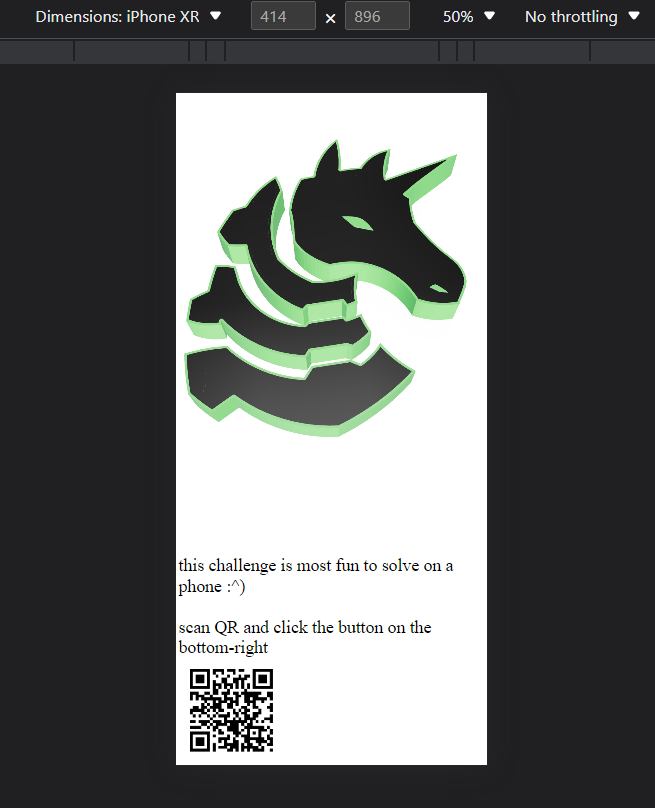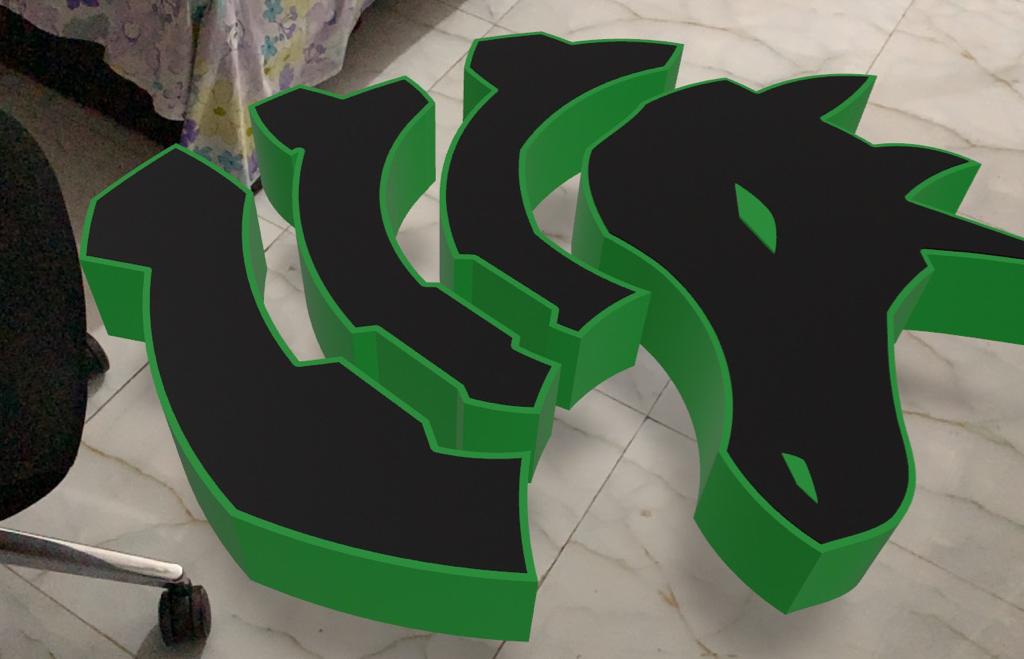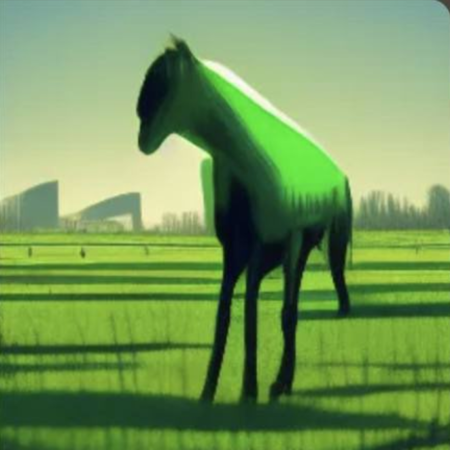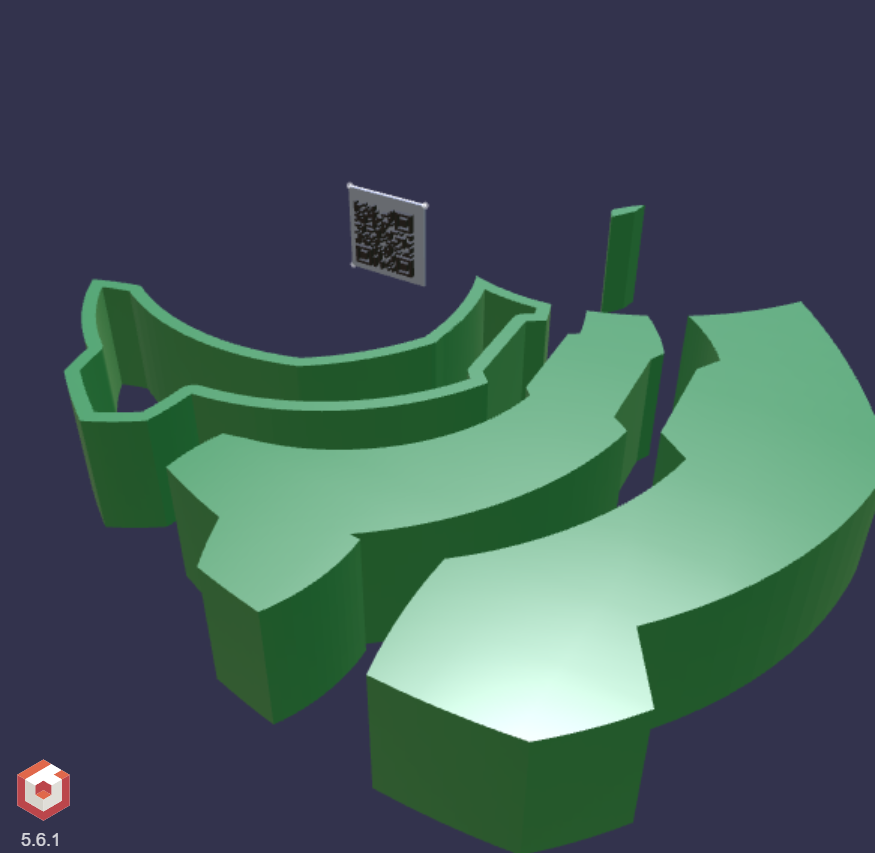🎯 UIUCTF 2022: AR Pwny



🧾 Description
Welcome to the meataverse!
http://ar-pwny-web.chal.uiuc.tfauthor: ian5v
🍦 Solution TL;DR
- Grab the GLB binary file from the page source & perform basic forensics
- Convert to glTF format and locate the flag segments
- Use a 3D rendering engine debugger to visualize & isolate the flag segments i.e QR codes
- Decode the QR codes & combine them to obtain the flag
🔎 Detailed Solution
📌 Step 1 : Web Inspection
Navigating to the challenge using a regular MS Edge browser, the webpage is basically a fancy SIGpwny logo in interactive 3D view.
Switch to mobile device? That's interesting! Open view source page with CTRL + U hotkey.
<!-- redacted section -->
<meta name="twitter:card" content="player" />
<meta name="twitter:title" content="hey there ctf player >:o) why dont u solve my challenge :^)" />
<meta name="twitter:image" content="0" />
<!-- redacted section -->
<meta name="twitter:player:stream" content="https://video.twimg.com/ext_tw_video/1553060639530225664/pu/vid/920x720/qT8hHQq3KZUFi7uo.mp4?tag=12" />
<!-- redacted section -->
<script type="module" src="model-viewer.min.js"></script>
<model-viewer style="width: 100%; height: 80%" src="pwny.glb" ar ar-modes="webxr scene-viewer quick-look" seamless-poster shadow-intensity="1" camera-controls enable-pan></model-viewer>
<!-- redacted section -->
Sweet! Looks like there are couple of suspicious signs with useful info:
-
A peculiar pwny.glb file detected, which may contain the model data for rendering. A quick web search shows that the GLB file format carries binary information about 3D scenes, models, lighting, textures and node hierarchy.
-
The 3D model is rendered by model-viewer, an open source web component by Google for web browsers as well as "Augmented Reality" environments.
-
Additionally, a fishy video link is lurking in the meta tags. Let's play the video.
The author must've been using an AR viewer app (challenge title says so as well)!
In case you're wondering. an AR viewer app overlays the 3D immersive object on the top of your physical surroundings, which can be visualized through the lens of a smartphone camera.
📌 Step 2 : What's in the Blackbox? 🗃
Before proceeding into forensics of the .glb data, let's follow the challenge instructions first.
-
First check whether impersonating a mobile client would do the trick. Open Edge Devtools (CTRL+SHIFT+I), toggle device emulator and refresh the page.
Sadly, there's no button on the bottom right for interaction as instructed, so this approach won't be useful.
-
Let's pick up an actual mobile device. Any recent smartphone model should have AR compatibility out of the box. Installing an AR viewer app (ex: Augment) and scanning the QR code takes us into the AR experience. Suddenly there's giant virtual pwny on my workstation floor!
For iOS devices, the minimum requirement for AR compatibility is iOS 11 running on A9 chip (that means any device model after iPhone 5 could do the job).
Searching every nook and corner around the surface don't seem to reveal any clue (note that I'm doing the search assuming the object has solid fill). Guess it's the time for plan B - digging up the model data.
📌 Step 3 : Whitebox 📦 Forensics
Running a quick string check with strings tool gives following results:
bijoy@kali:~/Desktop/uiuctf_22/web/pwny$ strings pwny.glb
glTF
JSON{"asset":{"generator":"Khronos glTF Blender I/O v3.2.40","version":"2.0"},"scene":0,"scenes":[{"name":"Scene","nodes":[0,1,2,3,4,5,6,7,8,9,10,11,12]}],"nodes":[{"mesh":0,"name":"flag-firsthalf","rotation":[-0.7071068286895752,-0.7071068286895752,0,3.0908616110991716e-08],"scale":[2.5827651023864746,2.5827651023864746,2.582765579223633],"translation":[2.0828332901000977,-0.5367418527603149,-2.838243007659912]}
# REDACTED REMAINING OUTPUT
It's clear that the file contains some JSON data (will come in handy), and a web search reveals that it is generated via a Blender add-on called glTF Importer and Exporter from Khronos Group.
Digging up a bit more, this glTF (GL Transmission Format) format turns out to be the clue. Basically, it's a stripped down JSON file that references the corresponding mesh, animation, and texture data in internal files for quick transmission needs. In contrast, it's distant cousin, our GLB format contains the glTF asset (JSON object, .bin and images) in a binary blob, just like the output suggested.
Opening the file in Visual Studio Code editor thankfully invokes a suggestion for glTF Tools extension for processing and analysis. (and that's why I always love VS Code ❤)!
Using the tool, apply Import from glb operation on the file to convert it to equivalent glTF file (with a .bin file popping up as expected). Let's inspect the JSON structure. What do we have here?
Looks like the flag is sliced in two and placed into the model, but the associated data needs to be graphically reconstructed for interpretation.
📌 Step 4 : Lost in Babylon 🕌
Peeking through the extension docs, the Preview 3D Model function should render the model through the common four rendering engines (namely Babylon.js, Cesium, Filament and Three.js ).
Adding a bit of context, BabylonJS is a powerful open source GUI system for displaying 3D gaming graphics in a web browser.
Switching into the glTF outline view reveals the tree structure of the scene nodes.
Hierarchically, the data structure is arranged in the following order:
scene > node > mesh > primitive > vertices & triangles
The structural pattern suggests that rendering only the flag-firsthalf and flag-secondhalf nodes minus the rest of the scene should bring the flag to light.
BabylonJS comes with a dedicated visual debugging tool called Inspector to show model wireframes, normal vectors, texture channels and allows scene exploration.
Cool! Just the thing we need. Toggle the Inspector icon on top right.
Expand the nodes until flag primitives are visible. Then use the show/hide toggle to remove all the other non-flag nodes one by one and voila!
The model was not solid after all, rather a hollow container for the flags! Those QR codes have been hiding inside the object all along!
Scan and decode the codes, and the flag slices are obtained.
Slice 1: uiuctf{welcome_2_the_meataverse_
Slice 2: erm_i_meant_pwnyverse}
Combining both, the final flag is obtained. ✌
⛳ Flag
uiuctf{welcome_2_the_meataverse_erm_i_meant_pwnyverse}
🧲 Alternative Solutions
Since the model was hollow, looking carefully inside the object using an AR app (see 📌 STEP-2) would have given away the QR codes pretty early (and save a lot of time ⌚)! My teammate solved it this way.
🙏 Acknowledgements
Regardless of approach, the challenge is pretty fun to solve. Credit goes to ian5v from SIGpwny.












